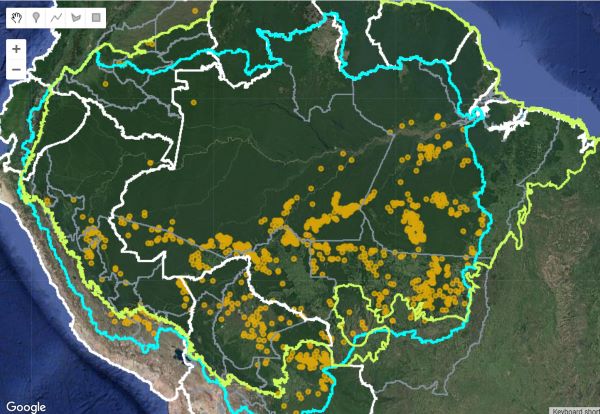Base map: Amazon fires 2022. The orange dots indicate the main locations of the fires. The green line is the Amazon biogeographic boundary and the blue line is the Amazon basin boundary. Data: ACCA.
72% of the large fires occurred in the Brazilian Amazon, where a key link between recent deforestation and fires was also identified.
Some 983 large fires were reported in the Amazon during 2022, affecting nearly 1 million hectares, reveals a new report by the Monitoring the Andean Amazon Project (MAAP).
The majority (72%) occurred in the Brazilian Amazon, followed by the Bolivian (15%), Peruvian (12%) and Colombian (1%). No major fires were detected in the other Amazonian countries.
The data was obtained based on a real-time Amazonian fire monitoring application from MAAP, which combines atmospheric and ground data, highlighting the largest fires.
The finding that in the Brazilian Amazon the majority of large fires (71%) burned recently deforested areas highlights the key link between recent deforestation and fires.
Furthermore, it is estimated that more than 120 of the large fires burned 58,000 hectares of recently deforested areas for new soybean plantations in the Brazilian and Bolivian Amazon.
However, it should be noted that compared to the previous two years, for which more than 2,500 large fires were documented annually, this fire season was less intense.
“This appears consistent with fire forecast models that predicted a ‘slightly active fire season’ in 2022 based on Atlantic Sea surface temperature,” says MAAP.
Additional findings from each country are presented below.
Brazilian Amazon
MAAP detected 704 large fires in the Brazilian Amazon between May and October 2022.
Early in the season, from mid-May to the end of June, there were 60 large fires that burned 25,000 hectares of areas recently deforested for new soybean plantations in the state of Mato Grosso.
In July, there was a shift to fires in areas recently deforested for new cattle pastures (see image).
Overall, of the total 704 large fires, 71% occurred in recently deforested areas (500 large fires).
These fires burned an estimated 285,000 hectares of recently cleared tropical forest, again emphasising the close link between large fires and recent high rates of deforestation in Brazil.
They also registered almost 100 forest fires (14% of the total), defined as large anthropogenic fires that burned standing (unlogged) forest.
These fires, which may have escaped initial burns in recently deforested areas or grasslands, burned about 110,000 hectares of Brazilian Amazon Forest.
Although concerning, these figures are much lower than those of the severe 2020 forest fire season, where 40% of the large fires burned 2.2 million hectares of Amazon Forest.
The other types of fires (in addition to recently deforested areas and forest fires) occurred in grasslands and older cultivated areas.
More than 50 of the large fires occurred in indigenous territories and protected areas. The most affected were the indigenous territories of Xingu and Capoto/Jarina.
The states of Amazonas (29%), Mato Grosso (28%) and Pará (26%) had the largest fires, followed by Rondônia (11%) and Acre (7%).
Bolivian Amazon
151 large fires were detected in the Bolivian Amazon between mid-May and mid-October 2022.
In the first part of the fire season (May-June), the vast majority of fires burned more than 26,400 hectares of areas recently deforested for new soybean plantations in the department of Santa Cruz (see image).
From July onwards, there was a shift towards more savannah fires in the department of Beni.
In September, several forest fires occurred in Santa Cruz, defined as large anthropogenic fires that burned standing forest (unlogged forest).
These fires, which may have escaped initial burns in recently deforested areas or in grasslands, burned about 110,000 hectares of Bolivian Amazonian Forest.
Several savanna fires affected the Noel Kompf Mercado National Park.
Overall, the 2022 fire season was not as intense as the previous two years, when many of the savanna fires escaped into the surrounding dry forest ecosystems.
Peruvian Amazon
122 large fires were detected in the Peruvian Amazon between June and mid-October 2022.
Most of the fires (71%) burned recently deforested areas (more than 56,000 hectares), a pattern similar to that of the Brazilian Amazon. These fires occurred mainly in the Madre de Dios (see image), Ucayali and Huánuco regions.
There were also numerous large fires (25%) in the montane grasslands in Cusco and other regions. These fires affected 6,100 hectares.
Finally, there were several forest fires, defined as large anthropogenic fires burning standing forest (unlogged forest).
The most notable was a large fire in the Ucayali region in October that burned 1,600 hectares of standing forest around the new Mennonite colonies. It is likely that this fire escaped the burning of large areas recently deforested by the Mennonites.
Colombian Amazon
MAAP detected 6 large fires in the Colombian Amazon in February and March 2022. Note that the fire season in Colombia is much earlier than in other countries.
Project data is an underestimate, as they started registering data after the start of the fire season.
Of the major fires they registered, five of them burned more than 1,300 hectares of recently deforested areas in Guaviare, Meta and Caquetá.






